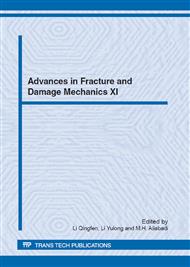[1]
T. Ishikawa and T. W. Chou, Elastic behavior of woven hybrid composites, Journal of Composite Materials, vol. 16, pp.2-19, (1982).
Google Scholar
[2]
Y. Jiang, A. Tabiei, and G. J. Simitses, A novel micromechanics-based approach to the derivation of constitutive equations for local/global analysis of a plain-weave fabric composite, Composites Science and Technology, vol. 60, pp.1825-1833, (2000).
DOI: 10.1016/s0266-3538(00)00064-6
Google Scholar
[3]
K. Woo and J. Whitcomb, Global/local finite element analysis for textile composites, Journal of Composite Materials, vol. 28, pp.1305-1321, (1994).
DOI: 10.1177/002199839402801402
Google Scholar
[4]
C. Chapman and J. Whitcomb, Effect of assumed tow architecture on predicted moduli and stresses in plain weave composites, Journal of Composite Materials, vol. 29, pp.2134-2159, (1995).
DOI: 10.1177/002199839502901603
Google Scholar
[5]
L. Li, P.H. Wen, M.H. Aliabadi Meshfree modeling and homogenization of 3D orthogonal woven composites, Composite Science and Technology Vol 71, PP 1777-1788, (2011).
DOI: 10.1016/j.compscitech.2011.08.014
Google Scholar
[6]
A. Bogdanovich, Multi-scale modeling, stress and failure analyses of 3-D woven composites, Journal of Materials Science, vol. 41, pp.6547-6590, (2006).
DOI: 10.1007/s10853-006-0197-2
Google Scholar
[7]
K. H. Ji and S. J. Kim, Dynamic direct numerical simulation of woven composites for low-velocity impact, Journal of Composite Materials, vol. 41, pp.175-200, (2007).
DOI: 10.1177/0021998306063360
Google Scholar
[8]
X. Tang and J. D. Whitcomb, General techniques for exploiting periodicity and symmetries in micromechanics analysis of textile composites, Journal of Composite Materials, vol. 37, pp.1167-1189, (2003).
DOI: 10.1177/0021998303037013003
Google Scholar
[9]
U. Galvanetto and M. Aliabadi, Multiscale modeling in solid mechanics: computational approaches vol. 3: Imperial College Pr, (2010).
Google Scholar
[10]
V. Kouznetsova, M. Geers, and W. Brekelmans, Multi‐scale constitutive modelling of heterogeneous materials with a gradient‐enhanced computational homogenization scheme, International Journal for Numerical Methods in Engineering, vol. 54, pp.1235-1260, (2002).
DOI: 10.1002/nme.541
Google Scholar
[11]
MIL-HDBK-17-2F Polymer Matrix Composites - Material Properties, in Composite Materials Handbook vol. 2, ed: Department of Defense, (2002).
Google Scholar


